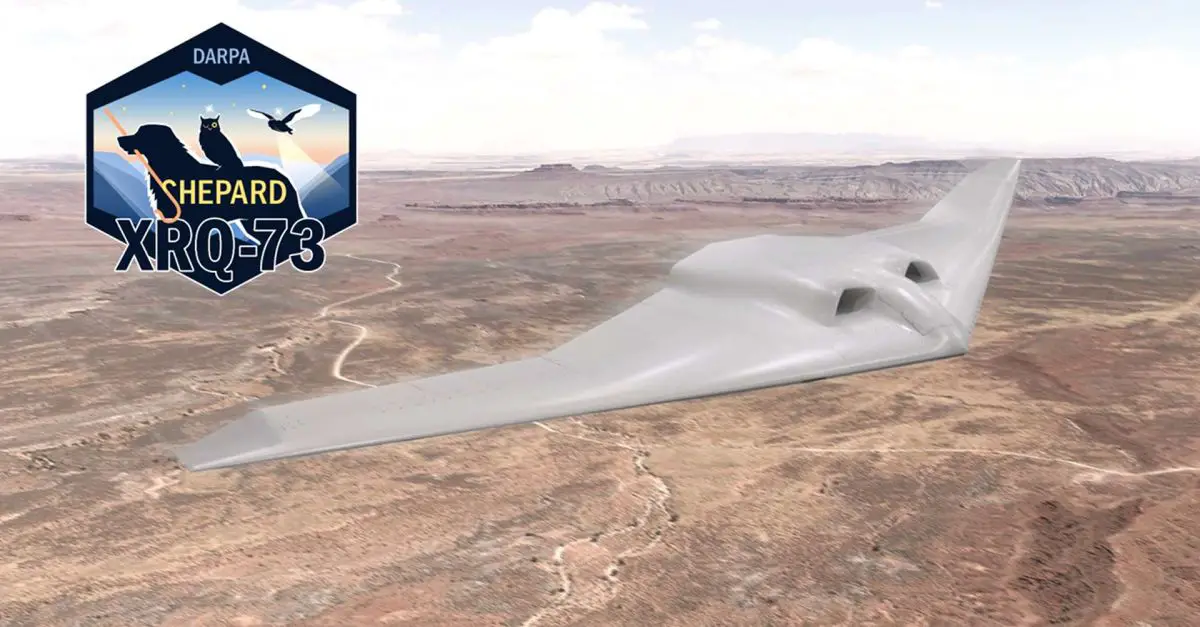Breaking News
US defense agency unveils new hybrid drone XRQ-73 for stealth reconnaissance.
On June 24, 2024, the US Defense Advanced Research Projects Agency (DARPA) officially designated its newest X-plane, the XRQ-73, a hybrid-electric uncrewed aircraft system (UAS) developed under the Series Hybrid Electric Propulsion AiRcraft Demonstration (SHEPARD) program. The SHEPARD program, building on the series of hybrid electric architecture and components from the earlier AFRL/IARPA Great Horned Owl (GHO) project, integrates emerging technologies to address system-level integration risks.
Follow Army Recognition on Google News at this link

The XRQ-73, classified as a Group 3 UAS, weighs approximately 567 kilograms, and is designed to operate below 5,486 meters and at speeds between 185 and 463 kilometers per hour. (Picture source: DARPA)
The Great Horned Owl (GHO) project, initiated in 2011 with the designation XRQ-72, utilized upper-surface propulsors and lacked stealth attributes. In contrast, the XRQ-73 features a flying-wing design with engines embedded in the airframe, improving radar low observability and noise reduction, which are essential for reconnaissance missions.
Steve Komadina, the SHEPARD program manager, stated that DARPA’s X-prime initiative focuses on rapidly maturing a new long-endurance aircraft design for specific missions. The SHEPARD program is maturing a specific propulsion architecture and power class to illustrate potential benefits for the Department of Defense. The DARPA team includes members from the Air Force Research Laboratory (AFRL), the Office of Naval Research (ONR), and warfighters, indicating a collaborative approach to developing this UAS.
Northrop Grumman Corporation’s Aeronautics Systems sector in Redondo Beach, CA, is the prime contractor for the SHEPARD program, with Scaled Composites, LLC, as a major supplier. Additional companies involved include Cornerstone Research Group, Inc., Brayton Energy, LLC, PC Krause and Associates, and EaglePicher Technologies, LLC.
The XRQ-73, classified as a Group 3 UAS, weighs approximately 567 kilograms, fitting within the category's weight range of 25 to 599 kilograms. It is designed to operate below 5,486 meters and at speeds between 185 and 463 kilometers per hour. Although initially expected to fly in 2023, the first flight is now anticipated by the end of 2024. DARPA has not specified the reasons for this delay.
The SHEPARD program aims to create an operationally representative UAS with an appropriate fuel fraction and mission systems while staying within the Group 3 weight limits. The hybrid-electric propulsion system is intended to extend the drone’s range and on-station time. The hybrid power approach also addresses noise reduction, which is a critical factor for low-flying UAS, as noted in a 2011 IARPA briefing.
An IARPA program briefing slide from 2011 identified noise as the "number-one signature" issue for low-flying UAS. The hybrid power approach chosen for the GHO, and now applied to the SHEPARD, was designed to eliminate gearbox noise. DARPA’s announcement emphasized the potential for rapid deployment of the XRQ-73, reflecting the agency’s focus on transitioning technologies from development to operational use. The SHEPARD vehicle, with its specific propulsion and stealth capabilities, is intended to enhance situational awareness in near-peer adversarial environments.
The XRQ-73 SHEPARD aligns with the U.S. military's need for systems capable of operating in contested environments, such as those presented by potential adversaries like China and Russia. The program’s developments aim to improve the U.S. military’s reconnaissance capabilities, providing commanders with critical situational awareness and potentially deterring future conflicts through improved operational readiness.


























